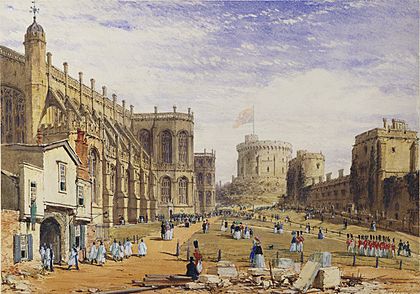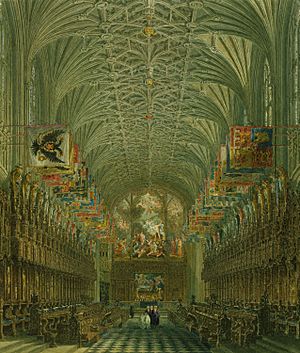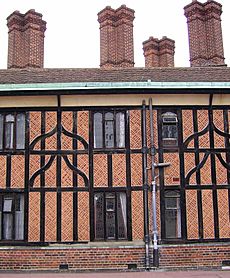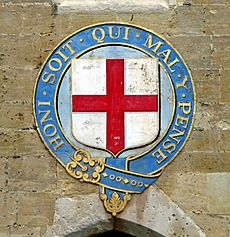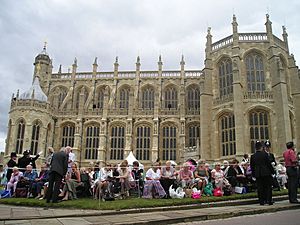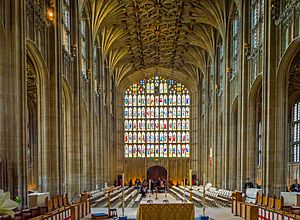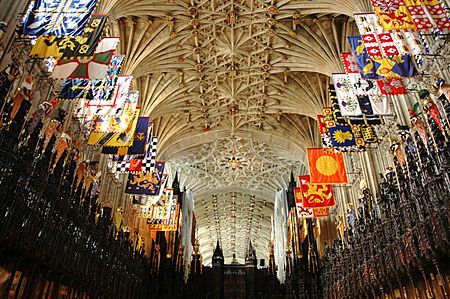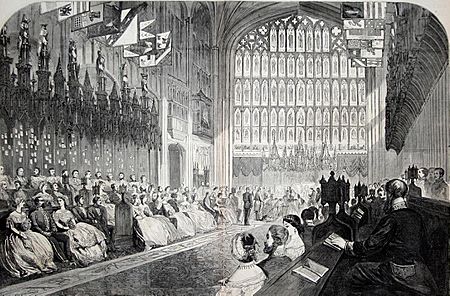St George's Chapel, Windsor Castle facts for kids
Quick facts for kids St George's Chapel, Windsor Castle |
|
|---|---|
| The King's Free Chapel of the College of St George, Windsor Castle | |
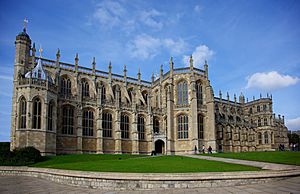 |
|
| 51°29′01″N 00°36′25″W / 51.48361°N 0.60694°W | |
| Location | Windsor |
| Country | England |
| Denomination | Church of England |
| Previous denomination | Roman Catholicism |
| Churchmanship | High Church |
| History | |
| Status | Chapel |
| Founded | 1475 |
| Dedication | St George |
| Architecture | |
| Functional status | Active |
| Heritage designation | Grade I listed |
| Style | Gothic |
| Years built | 1475 |
| Completed | 1511 |
| Specifications | |
| Capacity | 800 |
| Administration | |
| Deanery | Dean and Canons of Windsor |
| Diocese | Jurisdiction: Royal Peculiar Location: Oxford |
St George's Chapel is a famous church located within Windsor Castle in England. It is officially called The King's Free Chapel of the College of St George, Windsor Castle. This chapel is a special type of church known as a Royal peculiar, which means it is directly controlled by the King or Queen. It is also the main chapel for the Order of the Garter, a very old group of knights and ladies.
The chapel was first started in the 1300s by King Edward III. It was made much bigger and grander in the late 1400s. St George's Chapel is found in the Lower Ward area of Windsor Castle. The castle itself has been a home for the royal family for nearly 1,000 years.
Many important royal events have happened here, including services, weddings, and burials. Since the 1800s, St George's Chapel and the nearby Frogmore Gardens have become the main burial places for the British royal family, taking over from Westminster Abbey. A group called the Dean and Canons of Windsor is in charge of running the chapel. They get help from staff and a charity called The Society of the Friends of St George's.
Contents
History of the Chapel
Building the Chapel
In 1348, King Edward III created two religious colleges. One was at Westminster, and the other was St George's at Windsor. The new college at Windsor was connected to an older chapel built by Henry III in the early 1200s. This chapel was then dedicated to the Virgin Mary, St George, and Edward the Confessor. However, it soon became known simply as St George's Chapel.
A major rebuilding of St George's Chapel happened between 1475 and 1528. This project was started by King Edward IV and continued by Henry VII and Henry VIII. The old 13th-century chapel was made much larger, almost like a cathedral.
Challenges and Changes
The chapel faced a lot of damage during the English Civil War. In 1642, soldiers broke into the chapel and stole valuable items. More damage happened in 1643 when parts of the chapel were destroyed, and lead was taken from the roofs.
After his execution in 1649, King Charles I was buried in a small vault inside St George's Chapel. This vault also held the coffins of Henry VIII and Queen Jane.
King George III brought royal attention back to Windsor Castle. On August 12, 1776, the royal family started attending Sunday services at the chapel, which they called "the Cathedral." King George III was very dedicated to St George's Chapel. He helped fund a big restoration project from 1780 to 1790.
During the reign of Queen Victoria, more changes were made. The east end of the chapel's choir was rebuilt to honor Prince Albert. The Lady Chapel, which had been left unfinished by Henry VII, was completed and renamed the Albert Memorial Chapel.
By the early 1900s, the chapel needed urgent repairs. A ten-year restoration project began in 1920. As part of this work, a sculptor named Mahomet Thomas Phillips created a falcon and a unicorn statue in 1923.
The King George VI Memorial Chapel was built in 1969. It was designed by George Pace and is located between the Rutland Chapel and the north choir of St George's Chapel.
The Royal Beasts
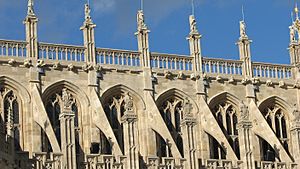
On the roof of the chapel, there are 76 statues of heraldic animals called the Royal Beasts. These statues represent 14 different animals. They include the lion of England, the red dragon of Wales, the panther of Jane Seymour, and the falcon of York. Other beasts are the black bull of Clarence, the yale of Beaufort, the white lion of Mortimer, and the greyhound of Richmond. You can also see the white hart of Richard II, the collared silver antelope of Bohun, the black dragon of Ulster, the white swan of Hereford, the unicorn of Edward III, and the golden hind of Kent.
The first beasts were from the 1500s, but they were removed in 1682. The stone they were made from was not strong enough. The statues you see today were added in 1925 when the chapel was restored.
Choir of St George's Chapel
The children who sing in the choir of St George's Chapel live and study at St George's School, Windsor Castle.
Order of the Garter
Garter Service
Members of the Order of the Garter gather at Windsor Castle every June for their yearly Garter Service. After having lunch, they walk in their special robes and symbols down to St George's Chapel for the service. This Garter Service was brought back in 1948 by King George VI. It was to celebrate 600 years since the Order was founded, and it has been an annual event ever since.
Heraldry in the Chapel
After new members are officially welcomed into the Order of the Garter, they are given a special seat in the chapel's choir. Above each seat, their unique heraldic symbols are displayed. A member's sword is placed below a helmet, which is decorated with a crest or crown. Above this, a large flag called a banner is hung, showing their coat of arms.
A small, decorated brass plate, called a Garter stall plate, is attached to the back of each seat. It shows the member's name and coat of arms. When a member passes away, their sword, helmet, and banner are removed. A special service is held in the chapel to remember them. During this service, the Military Knights of Windsor carry the banner of the deceased member and give it to the Dean of Windsor, who places it on the altar. However, the stall plates are never removed. They stay permanently on the seats. This means the chapel's seats are covered with about 800 plates from members throughout history.
Chantries and Chapels
St George's Chapel is home to some of the most important medieval chantry foundations that still exist in England. A chantry was a place where priests would pray for the souls of specific people, often founders or important figures. The college itself was part of a medieval chantry. There are also several smaller chapels and altars inside the main chapel. These were built to remember different English monarchs, important royal staff, and church leaders.
The impressive iron gates in the chapel's sanctuary and the locks on the doors were made by a medieval metalworker named John Tresilian.
Rutland Chantry
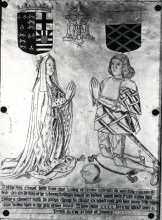
The Rutland Chantry chapel is located in the northern part of St George's Chapel. It was founded in 1491 to honor Sir Thomas St Leger and Anne of York. Anne was the older sister of kings Edward IV and Richard III. A brass memorial for Anne and Sir Thomas is still on the east wall of the Rutland Chantry. It says that the chantry was set up "with two priests singing forevermore."
The chantry got its current name from the Earls of Rutland, who were descendants of Anne and Sir Thomas. The tomb of George and Anne Manners is a main feature of this chapel. Their statues are carved from a special stone called English alabaster.
The chantry has five embroidered panels that show scenes from the Bible. These were made by an embroiderer named Beryl Dean and took five years to finish. Usually, only one panel is shown to the public, but you can ask to see the others.
Royal Weddings
St George's Chapel has been the location for many royal weddings, especially for the children of Queen Victoria. Here are some of the royal weddings that have taken place there:
| Year | Groom | Bride |
|---|---|---|
| 1863 | Albert Edward, Prince of Wales | Princess Alexandra of Denmark |
| 1866 | Prince Christian of Schleswig-Holstein | Princess Helena |
| 1871 | John Campbell, Marquess of Lorne | Princess Louise |
| 1879 | Prince Arthur, Duke of Connaught and Strathearn | Princess Louise Margaret of Prussia |
| 1880 | Alphons, Baron von Pawel-Rammingen | Princess Frederica of Hanover |
| 1882 | Prince Leopold, Duke of Albany | Princess Helen of Waldeck and Pyrmont |
| 1891 | Prince Aribert of Anhalt | Princess Marie Louise of Schleswig-Holstein |
| 1904 | Prince Alexander of Teck | Princess Alice of Albany |
| 1905 | Prince Gustaf Adolf of Sweden | Princess Margaret of Connaught |
| 1919 | Major John Gibbs | Lady Helena Cambridge |
| 1957 | David Liddell-Grainger | Anne Abel Smith |
| 1992 | Timothy Taylor | Lady Helen Windsor |
| 1999 | Prince Edward, Earl of Wessex | Sophie Rhys-Jones, Countess of Wessex |
| 2008 | Peter Phillips | Autumn Kelly |
| 2018 | Prince Harry, Duke of Sussex | Meghan Markle |
| Jack Brooksbank | Princess Eugenie of York | |
| 2019 | Thomas Kingston | Lady Gabriella Windsor |
In 2005, Charles III, who was then the Prince of Wales, and Queen Camilla, then the Duchess of Cornwall, received a special blessing from the Archbishop of Canterbury after their marriage.
Royal Burials
The chapel has been the site of many royal funerals and burials. Here are some of the people buried in the chapel:
Near the Altar
- George Plantagenet, Duke of Bedford, 1479; son of Edward IV.
- Mary of York, 1482; daughter of Edward IV.
- Edward IV, King of England, 1483.
- Henry VI, King of England, 1484 (moved from another location).
- Two unidentified children, possibly the Princes in the Tower (Edward V and Richard of Shrewsbury, Duke of York); sons of Edward IV.
- Elizabeth Woodville, Queen of England, 1492; wife of Edward IV.
- Princess Louise of Saxe-Weimar-Eisenach, 1832; niece of Adelaide of Saxe-Meiningen.
- Edward VII, King of the United Kingdom, 1910 (originally in the Royal Vault).
- Alexandra of Denmark, Queen of the United Kingdom, 1925 (originally in the Royal Vault); wife of Edward VII.
In the Quire
- Jane Seymour, Queen of England, 1537; third wife of Henry VIII.
- Henry VIII, King of England, 1547.
- Charles I, King of England, 1649.
- Stillborn son of Anne, Queen of Great Britain and Prince George of Denmark, 1698.
Royal Vault
- Princess Amelia of the United Kingdom, 1810; daughter of George III.
- Princess Augusta of Great Britain, Duchess of Brunswick-Lünenburg, 1813.
- Princess Charlotte of Wales, 1817.
- Stillborn son of Princess Charlotte of Wales, 1817.
- Charlotte of Mecklenburg-Strelitz, Queen of the United Kingdom, 1818; wife of George III.
- Stillborn daughter of Ernest Augustus, King of Hanover, 1818.
- George III, King of the United Kingdom, 1820.
- Prince Edward, Duke of Kent and Strathearn, 1820; father of Queen Victoria.
- Prince Alfred of Great Britain, 1820 (reburial).
- Prince Octavius of Great Britain, 1820 (reburial).
- Princess Elizabeth of Clarence, 1821.
- Prince Frederick, Duke of York and Albany, 1827.
- George IV, King of the United Kingdom, 1830.
- William IV, King of the United Kingdom, 1837.
- Princess Augusta Sophia of the United Kingdom, 1840.
- Adelaide of Saxe-Meiningen, Queen of the United Kingdom, 1849; wife of William IV.
- George V of Hanover, 1878.
- Baroness Victoria von Pawel-Rammingen, 1881.
- Princess Mary Adelaide of Cambridge, Duchess of Teck, 1897.
- Francis, Duke of Teck, 1900.
- Princess Frederica of Hanover, 1926.
- Prince Adolphus, Duke of Cambridge, 1930 (reburial).
- Princess Augusta of Hesse-Kassel, Duchess of Cambridge, 1930 (reburial).
Near the West Door
- George V, King of the United Kingdom, 1936 (originally in the Royal Vault).
- Mary of Teck, Queen of the United Kingdom, 1953; wife of George V.
King George VI Memorial Chapel
- George VI, King of the United Kingdom, 1969 (moved from Royal Vault).
- Princess Margaret, Countess of Snowdon, 2002 (ashes).
- Elizabeth Bowes-Lyon, Queen of the United Kingdom, 2002; wife of George VI.
- Prince Philip, Duke of Edinburgh, 2022 (moved from Royal Vault).
- Elizabeth II, Queen of the United Kingdom, 2022.
Albert Memorial Chapel
- Prince Leopold, Duke of Albany, 1884 (originally in the Royal Vault).
- Prince Albert Victor, Duke of Clarence and Avondale, 1892 (originally in the Royal Vault).
Gloucester Vault
- Prince William Henry, Duke of Gloucester and Edinburgh, 1805.
- Maria Walpole, Duchess of Gloucester and Edinburgh, 1807.
- Prince William Frederick, Duke of Gloucester and Edinburgh, 1834.
- Princess Sophia of Gloucester, 1844.
- Princess Mary of the United Kingdom, Duchess of Gloucester and Edinburgh, 1857.
Other Burials
- William Hastings, 1st Baron Hastings, in the north aisle.
- Anne Manners, in the private Rutland Chapel.
- George Manners, in the private Rutland Chapel.
- Charles Brandon, 1st Duke of Suffolk, 1545.
- Christopher Villiers, 1st Earl of Anglesey, 1631.
- Henry Somerset, 1st Duke of Beaufort and his family in the private Beaufort Chapel.
- Peniston Booth, Dean of Windsor.
- Lieutenant-General Sir John Elley, in the north quire aisle.
- Alemayehu Tewodros, 1879; son of the Emperor of Ethiopia.
See also
 In Spanish: Capilla de San Jorge (Castillo de Windsor) para niños
In Spanish: Capilla de San Jorge (Castillo de Windsor) para niños
- Choir of St George's Chapel, Windsor Castle
- Dean of Windsor
- Order of the Garter
- Windsor Castle


